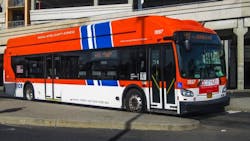Federal support for public transportation in suburban Nassau County Long Island continues to grow. When a crises occurred such as Superstorm Sandy in 2012, Washington was there. Additional assistance above and beyond yearly formula Federal Transit Administration (FTA) allocations were provided. In 2009, the American Recovery and Reinvestment Act provided more. In 2020, there was also CARES Act funding.
This year, Nassau County on behalf of Nassau Inter-County Express (NICE) Bus should receive $18,400,000 from Washington, D.C. Funding comes from several programs under the Fixing America's Surface Transportation Act.
In federal fiscal year 2020, the Federal Transit Administration will fund Nassau County NICE bus projects such as the purchase of 23 replacement compressed natural gas (CNG) buses at a cost of $13,800,000 with a federal share of $11,000,000; capital cost of third-party contracting (maintenance of fleet and support facilities to keep them in a state of good repair) at a cost of $7,500,000 with a federal share of $6,000,000 and purchase of 14 replacement paratransit vehicles at a cost of $1,400,000 with a federal share of $1,120,000. FTA will also fund facility capital replacement and improvements (shop improvements such as heating, ventilation, air-conditioning, CNG fueling station and bus area operations refurbishment) at a cost of $1,500,000 with a federal share of $1,200,000; non-revenue and support equipment (dispatch, patrol and service vehicles) at a cost of $600,000 with a federal share of $480,000 and engineering design services at a cost of $300,000 with a federal share of $240,000.
Nassau County can take advantage of FTA pre-award authority prior to grant approval. This affords the opportunity to start projects months earlier and incur costs for reimbursement at a later date after grant approval.
It has been 47 years, since Nassau County took control of all bus routes from private operators. Nassau County, New York state and the federal government combined have invested over $740 million in capital improvements. Operating subsidy dollars top more than $1 billion.
NICE services continue to be one of the best bargains around. Since the 1950s, the average cost of riding a bus in Nassau County has gone up at a lower rate than either the consumer price index or inflation. The Metro Card introduced in 1996 affords a free transfer between NICE bus and the NYC Transit bus or subway. Prior to this, riders had to pay two full fares. Purchasing either a weekly or monthly pass further reduces the cost per ride. Many employers offer transit checks, which pay even more of the costs.
In the end, it all comes down to the availability of increased funding for additional transportation service to serve residents. Operating subsidies are required to increase the level of service and reduce the amount of time one waits for a bus on existing routes. Same for adding more off-peak, evening and weekend service.
TANSTAFL - 'There ain't no such thing as a free lunch' or, in this case, bus ride.
Let us give thanks to the hard working men and women of the Nassau County Department of Public Works Transit Division and their colleagues at NICE Bus who made all of this possible. This includes preparing and filing FTA grants, obtaining millions of federal and state capital and operating assistance every year and successfully implementing all the capital projects and programs.
----------------------------------------------------------
Larry Penner is a transportation historian and advocate who previously worked 31 years for the Federal Transit Administration Region 2 NY Office. This included the development, review, approval and oversight for grants supporting billions in capital projects and programs on behalf of the Metropolitan Transportation Authority, New York City Transit bus and subway, Long Island Rail Road and Metro-North Railroad, MTA Bus and NYC Department of Transportation.
About the Author

Larry Penner
Larry Penner is a transportation advocate, historian and writer who previously served as a former director for the Federal Transit Administration Region 2 New York Office of Operations and Program Management. This included the development, review, approval and oversight for billions in capital projects and programs for New Jersey Transit, New York Metropolitan Transportation Authority, NYC Transit bus, subway and Staten Island Railway, Long Island and Metro North railroads, MTA Bus, NYCDOT Staten Island Ferry along with 30 other transit agencies in New York and New Jersey.
